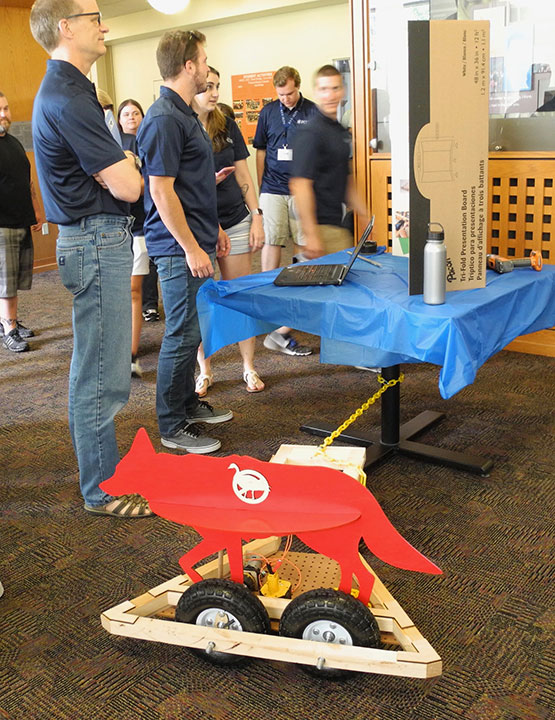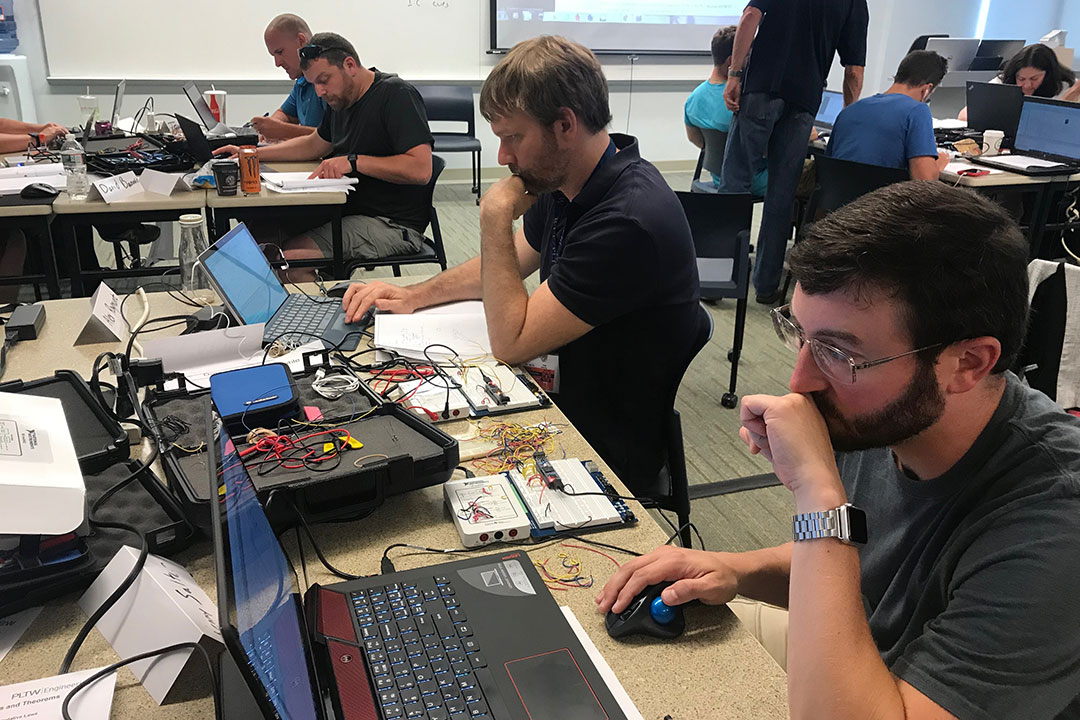U.S. high school teachers explore STEM topics and activities at RIT
K-12 teachers in the summer professional development program are on target to help students develop collaboration and problem-solving skills
J. Flinton, Project Lead the Way
Teachers from across the country came to RIT for Project Lead the Way Core Training, a professional development program where they learn new and updated skills in facilitating classes and the learning environment to help their students better understand math, science and engineering concepts as well as help them cultivate an interest in STEM fields
Even high school teachers need to go to summer school.
Teachers from around the country are in classes at Rochester Institute of Technology this summer for Project Lead the Way Core Training. Over several weeks, the high school teachers learn more about classroom teaching styles to better engage students, and they participate in activities to demonstrate engineering and mathematical concepts to their classes.
RIT is one of several Core Training hubs for Project Lead the Way, providing professional development programs for teachers since 1997. The national program provides resources for teachers to help students learn math, science and engineering concepts as well as help them cultivate an interest in STEM fields. Programs such as Project Lead the Way are a means to address the challenges of maintaining and growing a skilled workforce in the United States, ensuring that high school graduates are prepared for the rigors of college and to encourage more diversity in STEM programs and eventual careers.
“The program has evolved well beyond the ‘leaky’ STEM pipeline,” said George Zion, professor in RIT’s College of Engineering Technology and Partner/Manager of the RIT Project Lead the Way program. “It has helped high school students remain engaged in school overall but also in enjoying what they are learning.”
The high school teachers also enjoyed learning. They are among a growing group of Pre-K-12 educators who seek out Project Lead the Way training and engage in real-world learning projects themselves before sharing the experiences with their students when they all return to school in the fall.
 This summer’s design projects included building a mechanized fox to gently scare away geese that land on athletic fields for a rest.
This summer’s design projects included building a mechanized fox to gently scare away geese that land on athletic fields for a rest.This summer’s design projects included building a water filtration system for a washing machine and a ‘Goose Buster’ – a mechanized fox to gently scare away geese that land on athletic fields for a rest.
“It took us an afternoon to build this, and all the components had to come together,” said Andrew Spencer from Caledonia Mumford High School (N.Y.). He and David Jurewicz, (Oxford High School, Conn.) and William Mehr (Osbourn Park High School, Va.) built the Goose Buster, demonstrating the tech solution during an open house session. “Our challenge was in understanding how this would come to be, and the testing we did was part of the learning experience for us—and ultimately our students.”
Originally a pre-engineering program for high schools, Project Lead the Way developed similar programming for elementary and middle school students as well as new modules for children in pre-kindergarten. Classes for high school students take place throughout the academic year and are credit bearing, taken along with math and science classes, not as substitutes for these courses.
“It’s the hands-on activities and learning that I enjoy about this program,” said Lynn Wilson, a science instructor and coach in the Central Cambria School District (Pa.) who came from industry as a chemist and has been with the school district for three years. “While I am not an engineer, I love doing this work. What I’ve learned is, I don’t need to be the expert, but I can give the students and our teachers the encouragement, guidance and tools to be successful with these projects. I like the creative elements of it. You need the foundations, and once you have them, you can just run with this work.”
John Hjelle agreed. “We start our Project Lead the Way classes with brainstorming, asking the students what are the problems you are seeing in your world? What problems are you seeing in the world today? It is that dreaded ‘word problem’ that we recall from growing up and taking tests, but today our students are coming up with the situations to solve, and this is the start of them understanding the practical application of technology,” said Hjelle, a high school teacher from Nebraska, who worked with Peter Sewert (New York), Lindsay Roberts (Maryland) and Amy Giroux (Florida).
Students learn that understanding engineering and mathematical concepts today may help solve societal problems tomorrow.
“This is a chance for children to develop 21st century skills, even soft skills, starting at a young age. It’s an opportunity for them to learn to work collaboratively, to have a ‘growth mindset’ and to learn how to approach problems. It’s not just engineering they are learning about, it is about learning life skills,” said Jeanine Flinton, master teacher with Project Lead the Way. She teaches the PLTW curriculum in the Galway City School District in Saratoga County, N.Y.
Flinton also worked closely with RIT’s Project Lead the Way Training Partner team coordinating the summer training series that is held from July through August at the university. This year, more than 250 teachers from across the country will be guided by master teachers through instruction in facilitating classes and the learning environment, and practicing the activity, project and problem-solving pedagogical strategy in the Project Lead the Way Launch (Pre-K to fifth grade), Gateway (sixth to eighth grade), computer science, engineering and biomedical science program segments. (There are three pathways—computer science, engineering and biomedical science program segments.)








